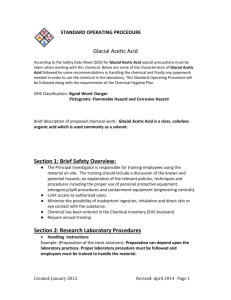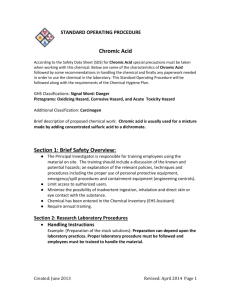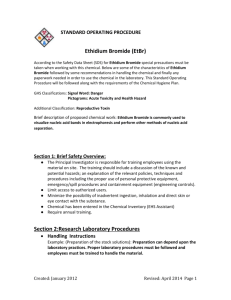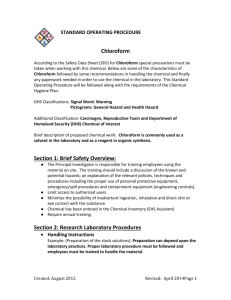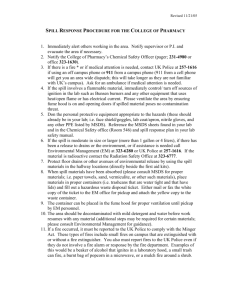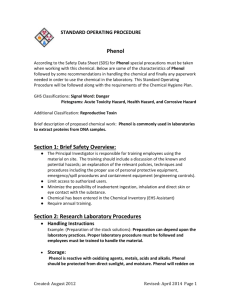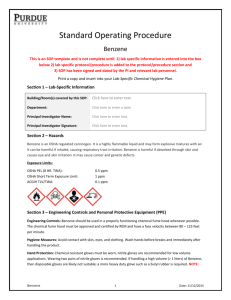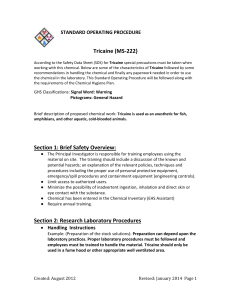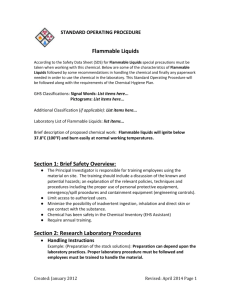Standard Operating Procedure Template
advertisement
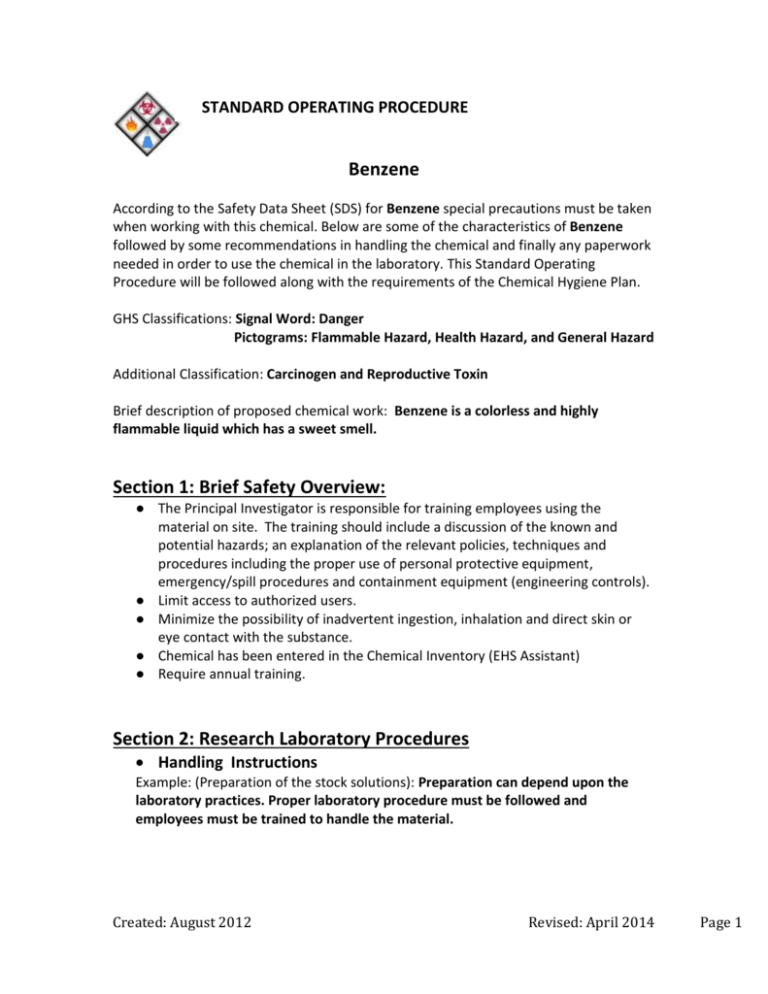
STANDARD OPERATING PROCEDURE Benzene According to the Safety Data Sheet (SDS) for Benzene special precautions must be taken when working with this chemical. Below are some of the characteristics of Benzene followed by some recommendations in handling the chemical and finally any paperwork needed in order to use the chemical in the laboratory. This Standard Operating Procedure will be followed along with the requirements of the Chemical Hygiene Plan. GHS Classifications: Signal Word: Danger Pictograms: Flammable Hazard, Health Hazard, and General Hazard Additional Classification: Carcinogen and Reproductive Toxin Brief description of proposed chemical work: Benzene is a colorless and highly flammable liquid which has a sweet smell. Section 1: Brief Safety Overview: ● The Principal Investigator is responsible for training employees using the material on site. The training should include a discussion of the known and potential hazards; an explanation of the relevant policies, techniques and procedures including the proper use of personal protective equipment, emergency/spill procedures and containment equipment (engineering controls). ● Limit access to authorized users. ● Minimize the possibility of inadvertent ingestion, inhalation and direct skin or eye contact with the substance. ● Chemical has been entered in the Chemical Inventory (EHS Assistant) ● Require annual training. Section 2: Research Laboratory Procedures Handling Instructions Example: (Preparation of the stock solutions): Preparation can depend upon the laboratory practices. Proper laboratory procedure must be followed and employees must be trained to handle the material. Created: August 2012 Revised: April 2014 Page 1 Storage: Highly flammable in presence of open flames and sparks. Reacts with oxidizers, bromine pentafluoride, chlorine, chlorine trifluoride, diborane, nitric acid, nitryl perchlorate, liquid oxygen, ozone and silver perchlorate. Benzene vapors and chlorine with light can cause an explosion. Chemicals should never be stored above eye level. Chemical containers must be closed and labeled. Location – Engineering controls Ventilation (example: Fume Hood, Canopy Hoods, etc): Fume Hood Designated area (specify): Fume Hood PPE required: Skin/Body Protection (example: Lab Coat) Laboratory Coat Eye protection Face shield Respirator (example: N95): Hand protection (example: Nitrile gloves): Teflon or Other Chemically Compatible Gloves Cleanup/Decontamination procedures for work area after use: Laboratory personnel should use 70% Ethanol to decontaminate work surfaces after use. Disposal Procedures All unused Benzene or waste must be collected and disposed of through Environmental Health and Safety. Waste must be collected in an appropriate specifically labeled, leak-proof container. Section 3: Occupational Exposures Routes of Exposure Skin – Hazardous if absorbed through skin. Inhalation – Very hazardous if inhaled. Ingestion- Very hazardous if ingested. Injection- N/A Created: August 2012 Revised: April 2014 Page 2 Toxicological Effects Acute Effects/ Precautionary Safety Measures: Inflammation of the eye is characterized by redness, watering and itching. Chronic Effects/ Precautionary Safety Measures: The substance is toxic to blood, bone marrow, central nervous system (CNS). The substance may be toxic to liver, urinary system. Repeated or prolonged exposure to the substance can produce target organ damage. Occupational Exposure Response and First Aid Measures Skin: Wash skin with plenty of water and remove contaminated clothing. Seek immediate medical treatment. Eyes: Flush eyes for at least 15 minutes while holding eyelids open. Remove contacts if they do not flush out. Seek immediate medical treatment. Inhalation: Remove victim from the exposure area and take to fresh air immediately. Seek immediate medical treatment. Do not perform mouth-tomouth resuscitation. Ingestion: Do not induce vomiting. Seek medical immediately treatment. Emergency Procedure for Chemical Spills and Accidental Releases Small Spills (less than 1 gallon): Small spills which do not enter drains can be cleaned by trained personnel. Proper PPE must be worn when cleaning the spill. Neutralize the spill with Activated charcoal or non-combustible material. Post the door with the chemical spill sign from the spill kit. Collect all contaminated materials in a bag labeled as “Benzene waste” and contact Environmental Health and Safety for chemical pickup. Large Spills (more than 1 gallon): Make sure that the fume hood is working properly for appropriate ventilation. Place some absorbent materials on top of the spill. Evacuate all personnel from the space and shut the door. Post the door with the chemical spill sign from the spill kit. Call Environmental Health and Safety Emergency Response Team and report the chemical spill. Created: August 2012 Revised: April 2014 Page 3 This Standard Operating Procedure must be placed in the Chemical Hygiene Plan and the SDS must be accessible. Also, all laboratory personnel must be familiar with safe handling practices (i.e., training with documentation of training) when working with these chemicals. This must be incorporated into the comprehensive chemical hygiene plan of the laboratory. If you have any questions regarding a comprehensive mandatory laboratory chemical hygiene plan please contact your Representative at Environmental Health and Safety (292-1284). For any other questions or concerns, please contact: PI contact information Name: Primary Contact Number: Emergency Contact Number: P.I. Signature ___________________________________________________________ Created: August 2012 Revised: April 2014 Page 4

